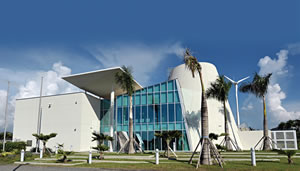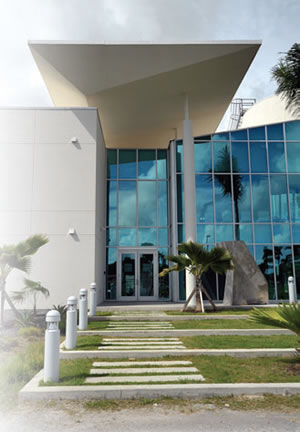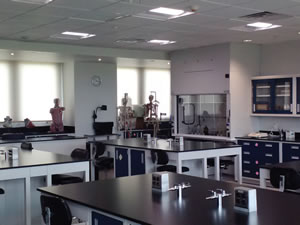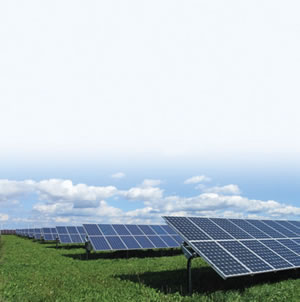Pathways to Greatness

PHOTOS COURTESY OF THE UNIVERSITY OF THE VIRGIN ISLANDS
Located in one of the most popular vacation spots and in the heart of the beautiful Caribbean, The University of the Virgin Islands (UVI) has far more to offer than sandy-white beaches, ample sunshine and a favorable offshore breeze.
Founded in 1962, UVI is a public, co-educational, land grant HBCU in the U.S. Virgin Islands (USVI). Approximately 2,500 students are enrolled in two campuses on two islands: the Albert A. Sheen Campus on St. Croix, and the St. Thomas campus.
A Challenging Quest to Meet
UVI’s Strategic plan, entitled “Pathways to Greatness” required financial stability and growth among a modern and safe university environment.
As for any university, these demanding tasks are laborious to accomplish, but for UVI, this feat was additionally challenging due to major budget cuts, energy rates at $0.51 per kilowatt-hour (kWh), and an island location.
A Foresight, a Vision and Rising Energy Costs
In 2002, UVI had the foresight to know something had to be done about rising energy costs. At $0.14 per kWh, energy costs were escalating quickly and the U.S. economy was struggling to recover from the recession of 2001.
Once a baseline was established, Aramark worked with UVI to complete low- to no-cost projects that included adjustments of the overall occupied and unoccupied temperatures and times; upgrading current HVAC controls and installing new ones; and installing occupancy sensors, solar roadways and parking lots. Projects were funded through a loan and grants from the Virgin Islands Energy Office. Since the inception of the program in 2003 UVI has saved over $2.6 million.

PHOTOS COURTESY OF THE UNIVERSITY OF THE VIRGIN ISLANDS
Caribbean Green Technology Center
The Caribbean Green Technology Center (CGTC, http://cgtc.uvi.edu) is an initiative that is housed in the College of Science and Mathematics at UVI. The facility opened in 2011 in response to the growing need for the advancement and development of alternative and renewable energy technology in the Virgin Islands and the Eastern Caribbean territory. The organization’s main objective was to become the driving force in promoting the transition of use for sustainable renewable energy in the Caribbean. CGTC serves as a hub for collaborative research on energy-related materials on both micro and macro scale in the Caribbean.
Caribbean Green Technology Center (CGTC) Benefits
- Enable research to revolutionize the way we convert, store, deliver and use energy
- Provide a platform for local legislators, government officials and the general public to learn about renewable energy (RE) technologies
- Provide assistance in alternative and renewable energy policy development
- Provide assistance with curriculum development and training teachers in RE at the K–12 level
The Center brings together researchers, industry leaders and policy makers to address and solve problems, and implement solutions that will lead to better lives for the people of the Caribbean. In so doing, CGTC has established the following four major thrust areas: Workforce Development, Education and Outreach, Research and Development and Policy.
The Center is actively involved in facilitating the transition toward cleaner and more sustainable energy in the Caribbean countries.
UVI Research and Technology Building
Beginning in 2006, Aramark Engineering Solutions, the Scott A. Natvig Design Company, and the Architectural Alliance firm were contracted to oversee the schematic design, design development and construction document phases of an 18,000+-square-foot LEED-certified building project on the 10-acre UVI campus site.
Through guidance and working in unison with UVI, RTPark was chartered to lead knowledge-based workforce and economic development in the USVI. As a public corporation and autonomous instrumentality of the USVI government, RTPark (www.uvirtpark.com) is associated with — and also separate from — UVI. UVI was instrumental in the formation of RTPark in 2002, however, and is a key stakeholder. RTPark serves as an epicenter for public sector, academic and commercial engagement. It also houses the Math and Science departments for UVI, which includes offices, classrooms and Biology and Chemistry labs.
RTPark has taken the initiative to deliver on the promise of sustainable design in the USVI. From optimized environmental and energy performance, to site sustainability, and with the use of renewables, RTPark’s mission has accomplished the inherent and increasingly practical value of “green” buildings in the USVI. Sustainable or recycled materials in the components of the design include:
Interior
- Recycled glass was incorporated in the kitchen and bathroom countertops
- Restroom partitions were fabricated from recycled cardboard and other components
- Sustainable bamboo materials can be found in furnishings and wood finishes
- Most floors are of polished concrete
Exterior

PHOTOS COURTESY OF THE UNIVERSITY OF THE VIRGIN ISLANDS
- Light exterior color of the building and roof are designed to reflect, rather than absorb, daylight radiant heat.
- North-south orientation of the long wing of the building is designed to minimize southerly exposure, which is subject to solar heating throughout the day, and capture the predominant prevailing easterly breezes.
- The project’s storm water and rainwater management systems reduce facility water demands.
- The landscape design and plantings include permeable pavements, vegetated conveyance swales, bio-filtration, underground detention in rain tanks of up to one million gallons of water and rainwater capture from the roofline for retention in underground cistern facilities.
- Energy demands are reduced through solar water heating, natural daylight, use of shading and prevailing breezes and high-efficiency lighting and cooling systems.
- Renewable energy sources, specifically a roof-mounted photovoltaic (solar array) system and a wind turbine, provide a significant portion of the electricity utilized by the building.
Solar Farm

PHOTOS COURTESY OF THE UNIVERSITY OF THE VIRGIN ISLANDS
UVI entered a new era in July 2013 with the signing of a power purchase agreement with New Generation Power (NGP). NGP will build two systems for a total of three megawatts, with expectations to produce 4.5 million kWh annually.
This renewable energy, along with other green initiatives, is expected to reduce UVI’s reliance on fossil fuels by at least 50 percent, while making UVI more environmentally friendly and providing cutting-edge research in the area of renewable energy for students and faculty. As part of the 20-year agreement, NGP will also provide charging stations for electric vehicles and solar labs for renewable energy classes and certificate training.
The three-mile-wide solar farm will be split between the St. Thomas campus, approximately two miles wide, and the Albert A. Sheen St. Croix campus, approximately one mile wide. The project is set up as a power purchase agreement where as a firm installs and maintains the system for more than 20 years. UVI will pay the firm a less-costly rate for electricity (as compared to current utility costs). At the end of the 20 years, UVI will have the option to purchase the system.
WEST HALL
The need for more residential space as well as constructing UVI’s first air-conditioned residence hall led to the development of West Hall, on the St. Thomas campus. West Hall accommodates 100 residents and overlooks the beautiful John Brewer’s Bay. The hall provides suite-style housing, and has a laundry room, study rooms, two common rooms and also a smart classroom. Sustainable and energy efficient policies are most evident in West Hall. Systems and policies include:
Air Conditioning — As evident throughout all campus buildings, set points are established for West Hall. The operating set point is 75°F +/- 2°. The temperature range can be adjusted individually in each space, however 73°F is the lowest setting for each room. All rooms have sensors with an alert system. If windows are left open, the air conditioning within that area will shut off .
Water Heaters — Hot water is produced by solar panels mounted on the roof. There are two backup systems for extended periods of cloudy days. Heat is recovered from the chiller, or a standard electric water heater if necessary.
Lighting Controls — All light fixtures employ a combination of heat and infrared occupancy sensors. As you enter a space, lights turn on automatically. Conventional switches are also mounted to manually turn off lights.
Plumbing System — As with all campus facilities, low-flow showerheads, tankless toilets and low-flow faucets are in West Hall. A water catchment system uses rainwater to supply irrigation and fire sprinkler water.
LEED Certification — LEED certification standards also encourage the use of locally grown and produced materials. For West Hall, these include hand-painted artwork and murals by local artists and handcrafted, locally produced concrete benches. Many of the plants and trees are native and grown by local nurseries.
The new residence hall is as eco-friendly as possible and still maintains an excellent place to live, work and collaborate.
This article originally appeared in the issue of .